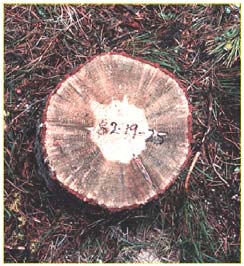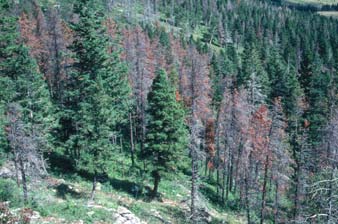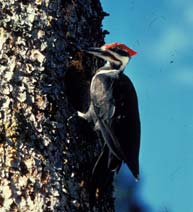Mountain pine beetle
Waterton Lakes National Park
The mountain pine beetleis a naturally occurring insect of the Rocky Mountain ecosystem. These small cylindrical insects attack and kill mature trees by boring through the bark and mining the phloem - the layer between the bark and wood of the tree. When conditions are favourable, populations of the mountain pine beetle can increase and large numbers of trees can be infected, killing large areas of mature lodgepole, whithe bark and limber pine.
Large outbreaks have helped shape the forests we see in Waterton Lakes National Park today. These forests are now productive habitats supporting a diversity of plant and animal species.
Life cycle of the Mountain Pine Beetle

Tree stump showing blue stain fungi
Mountain pine beetles normally have a one-year life cycle. In late summer, adults, which are approximately 5 mm (1/4") long, leave the infected trees in which they have developed. They then seek out living, green trees that they attack by tunneling under the bark and search for mates.
The beetles tunnel into the tree and lay eggs in vertical galleries under the bark. After the eggs hatch, the grub-like larvae spend the winter feeding under the bark. Larvae pupate in the spring and emerge as adults from July to September.
A key part of this cycle is the transmission of blue stain fungi from the beetle to the tree. Spores of these fungi are introduced by adults into the tree during colonization.
Fungi grow within the tree and, together with bark beetle feeding, weaken it. This mutual network of beetle galleries and blue stain fungi disrupts the movement of water within the tree and rapidly kills it. The fungi give a blue-grey appearance to the sapwood.
What to look for:

Trees killed by mountain pine beetle have red needles.
- red needles on the crowns of trees.
- eggs or larvae under the bark, or their galleries under the bark.
- " pitch tubes" -- bubbles of resin on the trunk where beetles tunnel into the bark.
- " sawdust" at the base of a tree or in bark crevices.
- woodpecker activity, such as holes in the trunk and bark chips on the ground.
What is the history of Mountain Pine Beetle in the Mountain Parks?
The MPB is present in all mountain national parks, but has only reached epidemic levels in Kootenay, Yoho and Waterton. In the 1940s, there was a major MPB outbreak in Kootenay National Park. 65,000 ha of pine forest were affected. A minor outbreak in Banff National Park affected 4000 ha. In the 1970s, a major Mountain Pine Beetle epidemic moved from the US Rocky Mountains into southeastern BC and southwestern Alberta, including Waterton Lakes National Park. Through the 1980s, the beetles moved through Kootenay National Park. A small outbreak occurred in southern Banff National Park in the early 1980s.
Mountain Pine Beetle has existed in Waterton at low or “endemic” levels for as long as pine trees have grown on the landscape. In 1977, forest conditions allowed normal populations to grow into an outbreak. The beetle population grew to epidemic proportions in 1979, rapidly spreading over low elevation lodgepole and limber pine, and to higher elevation whitebark pine. The outbreak, which lasted until 1982, was particularly obvious on lower mountain slopes in the Waterton and Blakiston valleys.
After 1982, beetle populations decreased and today there are naturally occurring populations of mountain pine beetle.
An old tree problem
Prior to the mountain pine beetle outbreak between 1977 and 1982, the majority of the pine stands in Waterton were mature. As a result of decades of fire suppression, continuous stands of older, stressed trees provided the right conditions for the outbreak. Approximately 10% of the pine forest succumbed to mountain pine beetle colonization.
Historically, when fires burned they would create a mosaic of forest patches of various ages, sizes and species. This made the landscape as a whole healthy and less susceptible to widespread insect outbreaks and the build-up of dead trees that fuel enormous wildfires.
Mountain Pine Beetle: A natural process in our forests
Mountain pine beetles are part of natural forest cycles and help to ensure that forests are healthy. When mountain pine beetles kill a lodgepole pine tree, they don’t just leave behind a dead and wasted tree. Other tree species and plants growing alongside or underneath the pine now have more light in which to grow. These species give diversity to the forest and in turn support other wildlife by providing shelter and food.
Mountain pine beetle normally affect mature or weakened lodgepole pine trees, thus helping to kick start the invaluable process of decomposition by recycling old or damaged trees. Decaying wood returns nutrients to the system while providing shelter and food for many plants and animals.
Waterton - Life after beetle

Pileated woodpecker
Pine species are still the dominant trees in many stands within the park. Because the forests of Waterton have aged another 20 years since the last outbreak, trees that were only marginally vulnerable in 1980 are now reaching an age that could make them susceptible to mountain pine beetle. However, because of forest diversity resulting from the last outbreak and fire activity, a significant outbreak is unlikely.
Waterton's forests are now diverse and productive habitats with lush understories. Many native species such as woodpeckers, Red-backed voles, martens and MacGillivary's warbler benefit from this enhanced forest diversity.
Related links
- Date modified :